
By Claire Cloutier, Team FSO contributing writer
Photos by Robin Ritoss and Claire Cloutier
A lot has changed for U.S. pairs skaters Audrey Lu and Misha Mitrofanov since they first teamed up in May 2016. Back then, Lu was just 13 years old, with zero pairs experience, while Mitrofanov was 18. During the ensuing five and a half years, Lu has grown into a young woman and graduated from high school, while Mitrofanov started his college education at the University of Texas at Dallas. Last year, the duo moved from Dallas to the Boston, Mass. area, when coaches Olga Ganicheva and Aleksey Letov relocated.
One thing that hasn’t changed over the years is Lu/Mitrofanov’s commitment to their on-ice goals. “As a team, we’ve always gotten along pretty well,” Mitrofanov stated. “And we’ve always been on the same page.”
Lu/Mitrofanov have progressed steadily up the ranks since they teamed up. The duo won the 2018 Junior National pairs title and placed fifth that year at Junior Worlds. Last season, Lu/Mitrofanov set new milestones as seniors by winning their first Grand Prix medal at 2020 Skate America and their first senior medal (pewter) at 2021 U.S. Nationals.
This season, Lu/Mitrofanov hope to put out consistent, solid programs to show their improvement as a team and help build their body of work. After starting their season with a sixth-place finish at Cranberry Cup, Lu/Mitrofanov then won a bronze medal at the John Nicks Pairs Challenge in New York City, where they skated one of the best long programs of their career to date. The duo are now preparing for their upcoming Grand Prix events, NHK Trophy and Rostelecom Cup, as well as 2022 U.S. Nationals.
Lu and Mitrofanov recently took some time to chat with Figure Skaters Online about how they got started in skating, what they enjoy most about the sport, and what their lives are like off the ice. The team also discussed their new programs, the progress of their technical elements, and their goals for the season.
Figure Skaters Online (FSO): Audrey and Misha, you both started skating when you were young. What initially drew you to the sport, and what did you enjoy about it?
Lu: I started skating at 4. I remember [that] I got on, and I was falling so much. But I never cried, and I didn’t get off the ice. I could tell that I really, really enjoyed the sport. My favorite part about it is definitely jumping. I like flying across the ice. It’s just a great feeling.
Mitrofanov: When I was born, I had a really weak immune system. The doctors told my parents to put me into sports, and so I tried a bunch of different sports. Four-year-old me liked figure skating the most. However, you know how Audrey said she was falling and she wasn’t crying? I was the opposite. I was falling and I was crying my eyes out the whole time. When I got off the ice, though, I’m like: “I want to do that again.” And my parents said: “Are you sure?” I said yes. So here I am still.
FSO: Misha, what did you enjoy most about skating when you were young?
Mitrofanov: I loved jumps. But what I enjoyed the most was getting a good reaction from the crowd. It wasn’t too often. (Laughs)
Lu: It depends what kind of reaction. (Laughs)
Mitrofanov: Exactly. I loved when the crowd loved my programs. That was everything. Because I thought that the hard work was paying off; people were enjoying the performance. That’s what I feel like figure skating is all about.
FSO: Both of you got into pairs when you were teens. What drew you to pairs?
Mitrofanov: For me, I was at a point when I had to move because I didn’t have any coaches in Houston [where he was living]. We tried with a bunch of [coaches], and we were not able to work it out. So it was either I had to move, or I was going to quit figure skating. My parents were like: “Do you want to try a new discipline?” And that’s when Emily Chan offered to try out pairs in Dallas [with me]. That’s when that journey started, at 17.
Lu: For me, I was actually doing singles at the time. It was the beginning of the season. And Misha and Alexey [Letov, their coach] were like: “Do you want to try pairs?” So we tried for a couple days. I wasn’t sure if I really wanted to do this, and I did singles for another month. Then we talked about it, and I thought about it, and [thought] that pairs is giving me opportunities. So I decided to switch to pairs.
FSO: Were you nervous about some of the pairs elements and whether they would be safe?
Lu: Yes. I was especially afraid of throws and twists, because I’m being thrown in the air. But throughout the years, I’ve overcome many fears.
Mitrofanov: Yes. I told Audrey and her mom that Audrey’s safety is my No. 1 priority. No matter what happens, during a performance, during a practice, I always want to make sure that she’s safe first, before anything else.
FSO: So you teamed up in 2016. At that time, you were a junior team; now you’ve transitioned into seniors. As you know, a lot of junior pairs don’t make it through that transition. A lot of teams split up at that point and re-team with other people. But you kept going together. How were you able to make that transition successfully?
Lu: I think when we started as a team, our foundation was really good. Because most pairs struggle with side-by-side jumps, and we had the side-by-side jumps down. Learning the pairs elements wasn’t easy, but I guess it’s easier than having to learn jumps. And, after we won Junior Nationals [in 2018], we felt really good. It helped our confidence as we moved into seniors.
Mitrofanov: As a team, overall we’ve always gotten along pretty well. Every team fights; every team has their problems. But Audrey and I, we’ve always been able to work them out. We’ve always been able to communicate with each other. And I think that was very important. And we’ve always been on the same page. The Olympics are our mindset; that’s where we want to go.
FSO: Did your coaches also help you make that transition from junior to senior?
Mitrofanov: Yes. They’ve been with us every step of the way; they’ve always had our backs. They’ve held us up whenever we were down. And they’ve helped us when we were climbing, as well.
FSO: In the last year or so, your coaches made the decision to move their training group from Dallas to Boston, in part due to problems with the rinks in Dallas. How has that transition been for you, and how do you feel about Boston as a training base?
Lu: The transition was actually really, really smooth. The Skating Club of Boston and everyone here has helped us with our training schedules, and given us so many opportunities, especially with the altitude room and skating in an Olympic-size rink every day. This rink is based around figure skating. So, it’s helped us a lot.
FSO: What about the Boston area itself? It’s a pretty big change from Texas. How do you like it?
Mitrofanov: I definitely miss the open roads in Texas, because I love driving. I love cars. However, the Boston area is amazing. It’s beautiful. The roads are not as nice … but I can get over that. (Laughs). The people here are amazing as well.
Lu: It has four seasons. (Smiles)
Mitrofanov: Yes, it has four seasons. And I do like snow. I also have to say, the food here is amazing. I know Audrey can say the same thing. Exploring new restaurants here has been an absolute blast. Because back in Texas, there’s a lot of Tex-Mex food. But here, there’s so much more diversity.
Lu: There’s all kinds of food.
FSO: Let’s talk about this season. This is the first Olympic season for you as a pair. What’s different about training and preparing for the Olympic season?
Lu: I think we try to not make it different. Obviously, it’s in the back of our minds that it’s the Olympic season. But we treat it like every other season. We work hard every day and set goals for ourselves. And we slowly build up. When we get to Nationals, we’re all prepared, and we just show what we can do.
FSO: This year, you’re skating to a remix of “Survivor” and “Toxic” for your short program. And you’ve selected “Ancient Lands” by Ronan Hardiman for your long program. Tell me how you chose these pieces and what you’re hoping to show with your programs.
Mitrofanov: The “Toxic/Survivor” program … Miss Olga, she wanted to do something different. She wanted to do a zombie-themed program for the short. At first, Audrey and I were like: “Are you sure?” But she said: “You should give it a try.” And we’re really happy that we did. We believe it’s an amazing program; we absolutely love it. We think it’s really different. We’re trying to set ourselves apart [by] having such a different program. We just have to continue training it to be able to portray that we’re zombies on the ice. Because I don’t think that’s a very common theme in figure skating yet. [Laughs]
FSO: Definitely not! That must be a bit of a challenge.
Mitrofanov: We’re always trying to push ourselves out of our comfort zone. Same thing last year with our Charlie Chaplin [free skate], which we absolutely loved. That was a program that we definitely had to push out of our comfort zone, in terms of being really super-happy and goofy.
FSO: What is the theme behind your “Ancient Lands” free skate?
Lu: It’s basically good vs. evil. I’m portraying good, and he’s portraying evil. Throughout the whole program, we’re fighting. And at the end, we both die.
Mitrofanov: We wanted to show a more dramatic side of our skating. We love doing that. I won’t say that’s our specialty; but that’s our favorite. We love showing drama–like when the music’s slow, being able to look at each other and show a connection–
Lu: Until it builds back up.
Mitrofanov: Yes.
FSO: Aside from the programs themselves, are there specific areas of your skating that you’re working on this season, to add polish and artistry?
Mitrofanov: I think clean skating, in terms of the edges. Being able to hold some edges longer, and show more of a flowy program, instead of a very straight line down the middle [of the rink]. That’s what we’ve been trying to work on in terms of PCS.
 FSO: Let’s talk about your technical elements. You are one of few–or perhaps the only– team in the world who performs a triple twist with both arms above the woman’s head [Lu’s head]. You’ve been performing that variation since 2016. How did you develop that move?
FSO: Let’s talk about your technical elements. You are one of few–or perhaps the only– team in the world who performs a triple twist with both arms above the woman’s head [Lu’s head]. You’ve been performing that variation since 2016. How did you develop that move?
Mitrofanov: Yes, I don’t think we’ve ever really seen another team do that. I guess the real story behind it is that I got a couple black eyes and bloody noses and stuff [from training the triple twist]. [Both laugh.] And we were like, “Okay, let’s just keep the arms above the head.” And it worked out for us. We think it’s a unique feature about our split twist, so we kept it. We really enjoy doing split twists like that.
FSO: Audrey, was it hard to learn doing the triple twist with one, or both, arms over your head?
Lu: Actually, it was harder to do it with no arms [up]. Because every time I’d open up, I’d go like this. [Sticks her elbows out to the side.] So with the arms up, I was just tight, and then I’d open up [shows arms separated but vertical], and it was a lot easier. It was still difficult, but [for us], it was easier than not doing arms up.
FSO: Did you have any concern as to whether it would negatively affect the height or the amplitude you would get in the air?
Mitrofanov: At first, yes. That was definitely a factor that we took into consideration. But we knew that, the more we worked on it as a team, the more strength I would build, and Audrey would build. We knew the height would come. We’re really happy [now] with the height that we have for the split twist. And we’re definitely very happy with the element. Because we usually get level 4 for the split twist–knock on wood. And we get nice GOE marks.
FSO: As a team, you’re known for your side-by-side jumps. A lot of U.S. pairs struggle with side-by-side jumps, but not you. What do you think goes into your consistency on that element?
Lu: Lots and lots of jumps. [Both laugh.]
Mitrofanov: I think it also stems from [the fact that] we were both singles skaters for a long time. Some teams, when they start very young as a pairs team, the singles skating is not able to be developed as much.
Lu: Right. Because the focus is more on pairs elements, and not really jumps and the technique on them.
Mitrofanov: So that’s the advantage we had, that plays in our favor. However, like Audrey said, we just practice a lot of jumps. We’ll have sessions where we have 30 minutes when she’s doing jumps and I’m doing jumps. And we’re not even doing them side by side, we’re just doing them by ourselves. Many, many repetitions. Because sometimes we’re on the ice with singles skaters, so for us, it’s just easier to do it that way.
FSO: When I interviewed your coach, Olga Ganicheva, she mentioned that you and Audrey often train on the ice with singles skaters in your group. How does that work out?
Mitrofanov: It works out amazingly well.. The Skating Club of Boston here has been accommodating us every step of the way. Back in Texas, we wouldn’t even have sessions for pairs. But here, we have sessions for pairs–which is unbelievable, it’s really nice–and then there are sessions where we’ll get on for singles skating. So we’ll focus on jumps, or spins. When we get on sessions for pairs, that’s when we’re able to do everything else, without ever having to worry.
FSO: You have, in the past, attempted and landed the side-by-side triple Salchow/euler/triple Salchow combination. Do you plan to keep that element in the program, and will you be going for it this season?
Lu: Yes. That is the goal.
Mitrofanov: In the beginning of the season [at Cranberry Cup], we felt we weren’t quite ready yet. However, we were definitely planning on putting it in for New York [John Nicks Pairs Challenge]. We have that notion that if something does go wrong on the first Salchow–like if one of us doesn’t have enough speed–we’ll call it to each other, and we’ll just do a double for the second [jump]. But our plan for this season is to do triple Salchow/half loop/triple Salchow.
FSO: When it comes to throw jumps, you’re doing throw triple loop and throw triple flip in your long program this year. Audrey, do you feel more comfortable now with throw jumps than when you started pairs?
Lu: Yes, definitely way more comfortable. [Smiles] I think it’s also repetition. I used to be afraid of them. But as I did more and more, it built my confidence. Now, it’s a lot better.
Mitrofanov: I’m able to throw Audrey further and higher [now], and she has zero fear. Which I think is amazing. And it’s helping us progress as a team.
FSO: What do you work on to increase your consistency with throws?
Lu: Off the ice, we always warm up with some check-out exercises, [doing] work for quickness. And on the ice, we don’t do a lot [of throws.] We do a certain amount, and then we move on. If one day, it’s not going well, then we leave it. That’s so the next time I come back to do it, I don’t lose confidence. I’ll know that yesterday was just a mishap, and today it will be fine. So we do a certain amount–at least five [throws in a practice]. And it has to be consistent–four out of five, or five out of five. And then we move on.
Mitrofanov: We try to approach it as quality over quantity. Because with throws, it’s a big impact on the female partner. So we want to make sure Audrey doesn’t hurt her knees or anything from just doing so many. God forbid that would happen. We don’t want to have any trauma like that.
FSO: That’s definitely very important! And what are you working on right now with lifts?
Mitrofanov: We’ve been upping the training for the lifts. For example, we’ll do all three lifts from the long [program] in a row. Down the ice, we’ll do one lift, and then we’ll go back [and] do the next lift in the long program. We’ll do three sets of that. Doing shorter time periods of rests between the lifts. So that even if I’m tired, I’m able to complete the lift. 
FSO: Did you make any changes to your lifts for this season?
Mitrofanov: We changed the first lift. We used to do a step lasso into a transition, and then I’d do crossovers. We took out the crossovers. For the transition, it used to be two arms. Now we changed it to one arm, so I have a one-armed dismount. For the second lift, we’re just trying to get Audrey to lean a little bit more. Usually she’s parallel to the ice, but [if she] leans a little more, [we’ll] get that fourth level.
FSO: Tell me something about your partner that most other people don’t know.
Lu: Usually Misha is really cheery and outgoing. But people don’t know that there’s a different side to him. He cares a lot. I guess he doesn’t really show it, but he cares a lot.
Mitrofanov: With Audrey, she’s the opposite. She’s shy at first. But once you really get to know her, she’s super outgoing. When people get to know her, she wants to make sure the person is there to help her, and not hurt her. But when she knows someone, she’s able to open up to them. I feel like she’s been able to open up to me, over the past few years. She has a really funny side that most people don’t see. She’s a really funny person, actually.
FSO: You guys have such nice things to say about each other! [Both laugh.] Audrey, I know that you graduated from high school. And Misha, you started college down in Texas. Where are you at right now with school?
Mitrofanov: This semester, I’m focusing on training. When I moved to Boston, I was able to [continue] my college back in Texas online. During the pandemic, it was online. However, this semester–because it’s the Olympic year–I just want to focus on skating and then see where my life takes me afterward. So for me, this semester, no school. Which is really nice. It’s a lot more free time, and more chill, and I can really focus on training.
FSO: Misha, you were attending the University of Texas at Dallas. Do you plan to continue there?
Mitrofanov: I’ve thought about, after this season, maybe applying to some universities in Boston. I’m not against that any more. I didn’t know if I wanted to finish at UTD, or transfer to a different school. That was a consideration when we were moving here last October. But now, because we’ve stayed here and we really like it, I do see plans of continuing to stay in Boston and going to university here.
Lu: I graduated [from high school] almost two years ago. Right now, I’m taking gap years to focus on skating. And then I’ll go from there.
FSO: What do each of you like to do in your free time? Misha, you mentioned cars and driving.
Mitrofanov: Yes. Audrey has heard enough [of this]. [Laughs] But that’s my favorite thing to talk about. I love to work on them, race them, anything with them. Any free time I have, it’s cars.
FSO: What car are you driving these days?
Mitrofanov: I had a beautiful Miata that my dad and I rebuilt back in Texas. It was a nice little car, very sporty. We used it for racing and that kind of thing. However, because I moved here, we sold it just recently. Because we understood that I wasn’t really using it that much. So I have my grandpa’s Toyota Forerunner now, because the roads here are awful.
FSO: What about you, Audrey? What do you like to do off the ice?
Lu: During the weekdays, I work at the Skating Club of Boston. I take care of their social media and do video and photo production. If I’m not doing that, I like hanging out with friends and family. I also like reading. And I volunteer a lot, too, for the adaptive skating program at Skating Club of Boston. I’m also part of their junior activities committee.
FSO: Let’s talk about your competitive season this year. The new season is just starting, but you’ve been pretty busy so far with two competitions and Champs Camp.
Mitrofanov: Yes. Honestly, it’s really nice, because last year during Covid-19, we only had two competitions. It’s awesome to be able to do a lot more, and for people to actually attend the competitions as well.
FSO: You opened your season at Cranberry Cup, which took place at your training rink. How did you guys feel about the experience, and doing a competition at your home rink?
Mitrofanov: It was definitely awesome. There were some complications outside of it. Because I live in an apartment, and my air conditioner broke, unfortunately. So I was sleeping very terribly during the competition week, and we didn’t perform as well as we wanted to. [Note: Cranberry Cup took place during an August heat wave in the Northeast.] The night before the long [program], I only slept for 45 minutes, so my strength and stamina went out the window. My arms literally just gave out, unfortunately. We want to progress, so that was definitely an eye-opener, to buckle down and focus on our training.
 FSO: Your next competition was the John Nicks Pairs Challenge in New York City. You skated well in both segments of the event, but particularly in the long program. How did you feel about that?
FSO: Your next competition was the John Nicks Pairs Challenge in New York City. You skated well in both segments of the event, but particularly in the long program. How did you feel about that?
Mitrofanov: We’re definitely really happy with how we skated the long program. We were really excited to put triple Salchow/half loop/triple Salchow into the program. That’s what we were planning on for this competition, so we’re really happy that [it] went well. And we were able to show smooth skating and solid elements overall.
FSO: You won the bronze medal, placing third. How did it feel to medal there?
Lu: Definitely, it’s a big confidence booster. We just need to continue training and making small improvements. Because we know that we can always get better.
FSO: Most of the top American pairs competed at both Cranberry Cup and John Nicks. What do you think about the level of pairs competition right now within the U.S.?
Mitrofanov: It’s great competition–very tough. It’s helping all of us to push ourselves to become better, which I think is the most important thing.
FSO: You have two Grand Prix competitions scheduled this fall–NHK Trophy and Rostelecom Cup. How do you feel about getting those two events?
Mitrofanov: We’re definitely very excited. We love Japan, so we’re really happy to go back to Japan. And we love Russia as well. We’ve been there before a couple times.
FSO: Misha, you’re fluent in Russian?
Mitrofanov: Yes. My parents and grandparents both moved [to the U.S.] from Russia. So when my sister and I were born, they taught us Russian. They wanted to make sure of that, and teach us about our culture.
FSO: That must come in handy when you have events there.
Mitrofanov: Yes. In the figure skating world, there’s a lot of Russian. [Laughs]
FSO: What are your goals for the Grand Prix and U.S. Nationals?
Lu: For the Grand Prix, we just want to show good, clean skates. Placement-wise … Well, obviously, we want to be on the podium. But our main goal is to show good, clean skates.
Mitrofanov: We’ve never really gone into a competition trying to think what placement for us. We never had that mentality. We were always like, let’s just do clean skates–and then whatever the judges decide, that’s what they decide at the end of the day.
FSO: Do you look on the Grand Prix also as a learning opportunity? Being exposed to top teams and getting feedback?
Lu: Yes! And just being able to go to these places. [Laughs]
Mitrofanov: It’s amazing. We’re just happy to be a part of the competition, and we’re really grateful for it.
